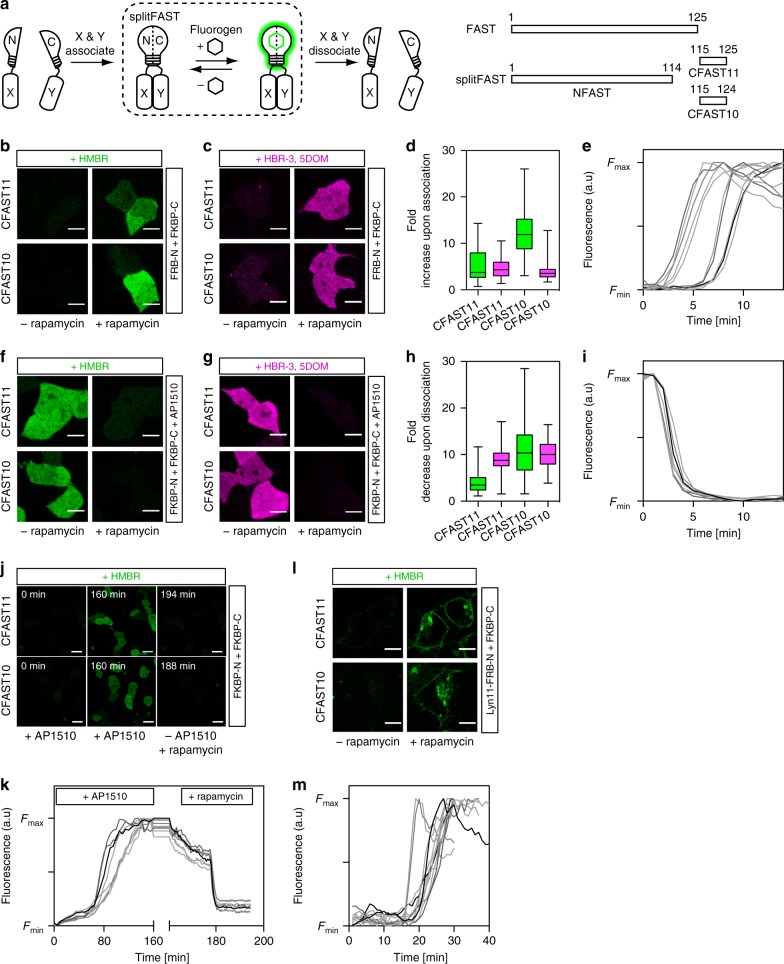Fig. 1.
Rapid and reversible complementation allows the observation of transient protein–protein interactions. a SplitFAST principle and design. b–e HEK293T cells co-expressing FK506-binding protein (FKBP)-CFASTn (n = 10 or 11) and FKBP-rapamycin-binding domain of mammalian target of rapamycin (FRB)-NFAST were labeled with 5 μM HMBR (4-hydroxy-3-methylbenzylidene rhodanine) (b) or 10 μM HBR-3,5DOM (4-hydroxy-3,5-dimethoxybenzylidene rhodanine) (c) and imaged before and after the addition of 100 nM rapamycin. Scale bars 10 μm. d Fluorescence fold increase upon FKBP-FRB association: box plot with n = 84, 83, 107, and 112 cells, respectively, from three to four experiments (whiskers represent the highest and lowest values); green = HMBR; magenta = HBR-3,5DOM. e Temporal evolution of the fluorescence intensity after rapamycin addition in HMBR-treated cells co-expressing FRB-NFAST and FKBP-CFAST11 (n = 11 cells; see also Supplementary Figs. 4a, 5a). f–i AP1510-treated HEK293T cells co-expressing FKBP-NFAST and FKBP-CFASTn (n = 10 or 11) were labeled with 5 μM HMBR (f) or 10 μM HBR-3,5DOM (g) and imaged before and after the addition of 1 μM rapamycin. Scale bars 10 μm. h Fluorescence fold decrease upon FKBP-FKBP dissociation: box plot with n = 142, 175, 219, and 125 cells, respectively, from three to four experiments (whiskers represent the highest and lowest values); green = HMBR; magenta = HBR-3,5DOM. i Temporal evolution of the fluorescence intensity after rapamycin addition in AP1510-treated cells co-expressing FKBP-NFAST and FKBP-CFAST11 (n = 8 cells; see also Supplementary Figs. 4b, 5b). j HMBR-labeled cells co-expressing FKBP-NFAST and FKBP-CFASTn (n = 11 or 10) were firstly treated with 100 nM AP1510 for 160 min, then AP1510 was removed, and 1 μM rapamycin was added. Selected frames are shown (see also Supplementary Fig. 6, Supplementary Movie 1, and Supplementary Movie 2). Scale bars 30 μm. k Temporal evolution of the fluorescence intensity upon sequential treatment of HMBR-labeled cells co-expressing FKBP-NFAST and FKBP-CFAST11 with AP1510 and then rapamycin (n = 8 cells; see also Supplementary Fig. 6). l HEK293T cells co-expressing Lyn11-FRB-NFAST and FKBP-CFASTn (n = 10 or 11) were labeled with 5 μM HMBR and imaged before and after the addition of 100 nM rapamycin. Scale bars 10 μm. m Temporal evolution of the fluorescence intensity after rapamycin addition in HMBR-treated cells co-expressing Lyn11-FRB-NFAST and FKBP-CFAST11 (n = 9 cells; see also Supplementary Fig. 7)

